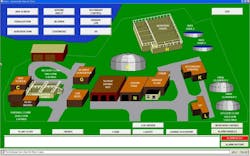Plano, Illinois is a small town about 50 miles southwest of Chicago on the Fox River. Chiefly, it was famous for being the site of the first factory that built McCormick Reapers-- the company that eventually became International Harvester. The factories are in ruins (listen up, industrial archaeologists!) and the town is now probably a lot smaller than it was in its heyday...it clocks in at about 12,000 people. That's a huge increase since 2000, probably because it is becoming a Chicagoland suburb.
Several years ago, the wastewater department of the City of Plano, run by a very sharp guy named Darrin Boyer, decided that his city needed to grow up technologically.
See, when I was working with water and wastewater utilities a long time ago, their monitoring and control capabilities were directly proportional to their size. The bigger the utility, the more cool new technology they could afford. The smaller the utility, the more use they made out of manpower.
But that has changed. Manpower is now rare and expensive. Cities have had to lay off workers to make ends meet. People are less and less interested in careers in water or wastewwater.
The thing that has helped Darrin Boyer, though, is the fact that the cost of the technology for monitoring and controlling his wastewater treatment plant has come down out of the stratosphere to the point where any size plant can afford state-of-the-art control systems.
There are several reasons for this. One is that the cost of technology itself has come down, through the use of more COTS (commercial off the shelf) products, like PCs and cell phones, and the increasing power of microprocessors as applied to PLCs and PACs by people like Rockwell. I mention them specifically, because it was Rockwell that Darrin chose for the Plano Water Reclamation Plant.
The other reason is the rise of a new type of contractor: the control system integrator. CSIs have significantly less overhead than the triad of A/E firm+Contractor+Electrical Sub and the vendors, with the electrical subcontractor and the A/E firm at loggerheads over who's supposed to have system responsibility. On a small project, like Plano's for example, the asset owner doesn't really have to deal with anybody but his chosen system integrator. The integrator takes care of whatever design elements are required, does the documentation, SAT (site acceptance test), FAT, (factory acceptance test), installation, training the operators and maintenance people and helping to maintain the system. And unlike the traditional triad above, the control system integrator is willing to take system responsibility for the project. No fingerpointing. The buck stops with the CSI.
In the case of Plano, the CSI in question is Ci&S, Complete Integration and Services of Peru, IL. Owned by Robert Baker, they do a large part of their work in water and wastewater. And Paul Sobin, Ci&S' senior programmer did much of the work on the Plano project.
Baker, Sobin and Boyer agreed that the control system would be a SCADA system, rather than a DCS, because the SCADA system had less software "overhead" and the field centers could easily control themselves in the event of loss of communication. Also, the various buildings from the headworks to the discharge were spread over a significant "campus" area.
Control can be accomplished from the control room (basically, a PC on Darrin Boyer's desk) or from HMI panels located at each control segment as you can see from the picture.
Recently, Darrin and Sobin have been experimenting with mobile apps which will give Boyer the ability to respond to alarms and at least do limited control from wherever he is. "I used to have a pager, and it never failed that when I was sitting down to dinner in a restaurant, the thing would go off and I'd have to leave. I've paid for a lot of cold food I didn't eat." With the new smartphone apps, he can answer an alarm, decide on how serious it is, take some action, and finish his dinner before heading over to the plant.
Plano isn't alone. There are plenty of small towns that are working with state-fo-the-art control systems thanks to simpler, smarter controllers and Control System Integrators that know how to make them work.
About the Author
waltboyes
waltboyes

Leaders relevant to this article:

